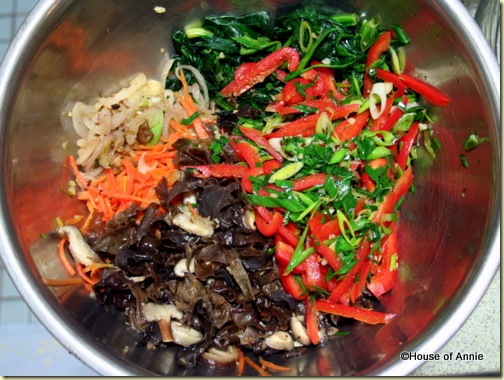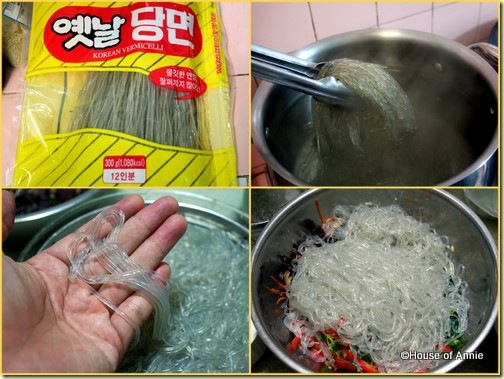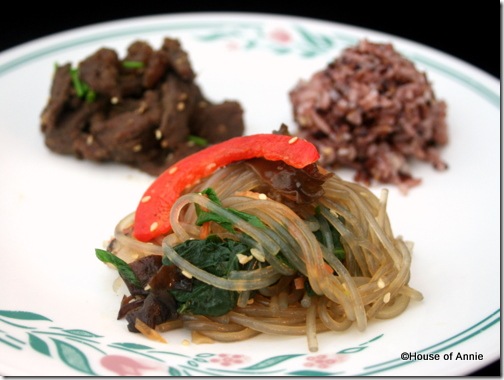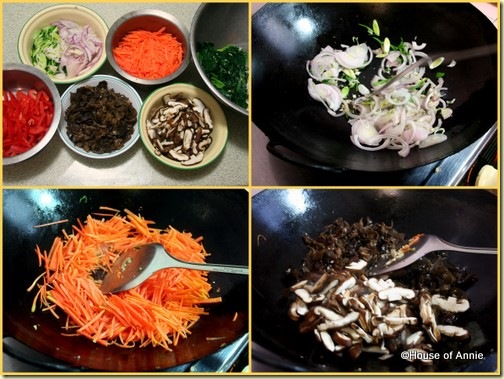Personally, this was one of the first dishes that I LOVED in Korean food.
I promised that I would write this recipe down for you last time when I posted on how to make Bulgogi. This recipe calls for a bit more work in terms of prep but the pay-off is really delicious so I think it’s worth it. And if you have spent enough time in the kitchen cutting veggies, then this should not be too hard for you.
Crazy for Korean
Before leaving Malaysia for the US, I had never before tried Korean food. When I got to Hawaii, I found that people there were crazy for kimchee and Korean plate lunches (which by the way, is such a Hawaiian thing—I never found them in San Jose). In case you didn’t know what a Korean plate lunch was, it was normally an offering of 1-2 main meat dishes (Kalbi, Bulgogi, Meat or Fish Jun, Grilled chicken, etc) and four sides (napa cabbage kimchee, tofu, spinach, beansprouts, seaweed, other types of kimchee, jap chae, etc) served with two scoops of rice and a scoop of mac salad (don’t you love Hawaiian plate lunches?).
I enjoyed these plate lunches a lot and did miss them when we got to San Jose. Thankfully, there were enough other Korean restaurants in San Jose to make up for the lack of plate lunches. And whether in Hawaii or in San Jose, I always ordered jap chae.
Combining Colors and Flavors
So again, coming back to the prep. It is quite a bit to prep as you can see in the picture below. There are many ingredients that are put into my jap chae. Now, if this seems too much for you, then just pick and choose some of the vegetables instead of using them all. I just like to use this combination because of the pretty combination of colors!
If you really had to choose, make sure you include the onions, spinach, green onions, and the wood ear mushrooms. I believe these are all quite common in most jap chae (jap chaes?). Oh, and of course, don’t forget the minced garlic! If you wanted to add some meat, you could include some finely sliced beef or pork but this time around, since I had made a huge dish of bulgogi, I gave the meat a miss. You are free to add it in (don’t forget to season the meat with a bit of soy sauce, sugar and sesame oil).
Jap Chae Ingredients
Once you’ve cut up all your veggies, the rest of it is quite easy. It’s just a matter of sautéing your ingredients, boiling the noodles, and then adding the seasonings. Give it another quick stir in your wok to put them all together and there you have it, jap chae! Garnish with toasted sesame seeds for that extra sesame fragrance and your dish is ready. Trust me, it won’t last long on the table once it’s served. It is that good!
Jap Chae Recipe
Ingredients
300g/ 8oz Korean vermicelli (also known as sweet potato starch noodle)
2-3 Tbsp vegetable oil
3-4 large cloves garlic, minced fine
1 large red or yellow onion, sliced
3-4 green onions (leeks will also work), sliced diagonally
1 large carrot, julienned fine
1 red bell pepper, sliced
4-6 shiitake mushrooms (fresh or rehydrated is fine), sliced
4-6 fresh wood ear mushrooms (rehydrated is fine), sliced
1 bunch of spinach, cut in thirds
2 Tbsp toasted sesame seeds
2 Tbsp soy sauce, or to taste
2 tsp sugar, or to taste
2 tsp sesame oil
kosher salt and freshly ground black pepper, to taste
Method
1. Start a large pot of water boiling on one burner.
2. On another burner, heat up a large frying pan on medium heat and add a little sesame oil. Add 1 tsp minced garlic. Lightly brown the garlic, then add spinach and stirfry. Add a pinch of salt. Stirfry till spinach is wilted and bright green. Dish out and place in a large mixing bowl.
3. Heat up a little bit more vegetable oil. Add a little bit more garlic. Lightly brown garlic, then add sliced onions and leeks (if using). Add a pinch of salt and stirfry till onions are translucent but not brown. Dish out and place in the same bowl.
4. Add a little bit more vegetable oil and more minced garlic. Lightly brown the garlic, then add the julienned carrots. Stirfry the carrots till they are just cooked through, about 3-4 minutes, seasoning with a pinch of salt. Dish out and place in the same bowl.
5. Add another tablespoon of oil and the rest of the garlic. When garlic is lightly browned, add shiitake and wood ear mushrooms and stirfry for about 3-5 minutes. Dish out and place in the bowl.
6. Add just a little bit more oil, and toss in the sliced bell pepper and green onions. Give it a quick stirfry, about a minute, then remove and place in the bowl.
Korean Jap Chae Ingredients

7. When the pot of water has come to a boil, toss in your sweet potato starch noodle and cook it following the instructions on your packet of noodles. Make sure to test that noodle is cooked through before taking it out. Drain noodles, and run under cold water.

8. Put noodles, and all the vegetables in the mixing bowl back into your frying pan or wok and add your soy sauce, sugar and sesame oil. Toss on medium heat to mix ingredients. Taste and adjust seasoning—the flavors should be salty with a hint of sweetness. Finally, add freshly ground black pepper and toasted sesame seeds to noodles. Mix into noodles.

9. Dish out and place on a large plate. Garnish with more toasted sesame seeds.
Serve this dish alongside other Korean main dishes like Bulgogi or Kalbi. Other sides that you can choose to serve with it include Kimchee, Stirfried Beansprouts, and Seaweed Soup.
Korean Jap Chae with Bulgolgi
Even though jap chae is counted as a side dish, you could totally eat this on its own. The vermicelli, meat and vegetables are all combined with a lovely soy sauce based sauce. That, along with the sesame oil and seeds give this dish the most amazing savory sweet flavors. When you think of all the different things that go into this dish, it’s no wonder that it’s so addictive and full of flavor—the umami factor is definitely a big part of its draw.
Cheers, Annie

I am entering this recipe into the Presto Pasta Nights roundup, hosted this week by Cook With Pia.
Other Jap Chae recipes from: Steamy Kitchen, Maangchi, Eating Club Vancouver, Momofuku For 2, and Koko Cooks


I love this dish because it reminds me of Chinese cold noodle dishes. I also like it because it is not greasy and is vegetarian. It’s so colorful. I go to Korean market in town to buy them from the sort of like a deli counter. They sell them by the pound. I do not see it as a main dish in Korean restaurant. Thanks for sharing the recipe. I am tempted to try it.
Have you thought about making kimchi? It will be great!
I made this to go alongside Bulgogi and had somewhat mixed feelings about it. It had some good flavors, but I didn’t feel like they complemented the Bulgogi. But, I’m new to Korean food, so I can’t argue with tradition.
My biggest gripe was that it was too oily. I don’t use Teflon, so perhaps I need more oil than you to cook each batch, but I tried to minimize it. When cooking the vegetables in separate batches, it adds up. Next time I will try to combine more vegetables with similar cooking times so that I can do it in fewer batches and use less oil.
On the plus side, I’ve been gradually overcoming my dislike of shitake mushrooms; trusting your recipe, I put plenty in, and actually liked them this time. Overall, three stars.